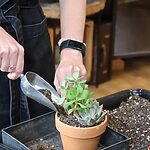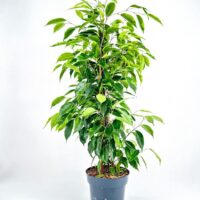Ficus Benjamina Ansastasia Weeping Fig Plant
Ficus Benjamina commonly known as a Weeping Fig houseplant has lovely, shiny, dark green leaves with light green variegation on arching branches.
Transform your home or workplace into a lush, relaxing sanctuary with the stunning Ficus! The plant is well known for its air-purifying properties and ability to filter out toxins and pollution. Perfect for both novice and experienced plant owners. Perfect as a statement plant for the living room or bedroom. Will thrive also in kitchens and bathrooms as can enjoy higher humidity.
This low-maintenance plant will thrive also in offices and other workspaces. Ideal for terrariums, moss bowls, vivarium and other botanical creation.
Care Guide and Troubleshooting for Ficus Benjamina ‘Anastasia’ (Weeping Fig Plant)
The Ficus Benjamina ‘Anastasia’, also known as the Weeping Fig, is a popular indoor plant known for its elegant, glossy green leaves with lime-green variegation. It’s an excellent choice for homes and offices, adding a tropical feel to indoor spaces. However, like many ficus varieties, it requires proper care to thrive and maintain its lush appearance.
Care Guide
Light:
- The Ficus Anastasia prefers bright, indirect light but can tolerate some direct sunlight. If grown in low light, it may lose its variegation and become leggy. Avoid placing the plant in dark corners, as insufficient light can cause leaf drop.
Watering:
- Keep the soil consistently moist but not waterlogged. Water the plant when the top 2-3 cm of the soil is dry. Be careful not to overwater, as it can lead to root rot. During winter, reduce watering as the plant’s growth slows down. Ensure the pot has good drainage to prevent standing water.
Humidity:
- Ficus Benjamina thrives in higher humidity levels. If your home is dry, especially in winter, consider misting the leaves or using a humidity tray to maintain optimal moisture. Dry air can cause the leaves to turn yellow and fall off.
Temperature:
- This plant prefers temperatures between 18°C and 24°C. Avoid placing it near cold drafts, air conditioners, or heating vents, as sudden temperature changes can cause stress and lead to leaf drop.
Soil:
- Use a well-draining potting mix, such as a combination of regular houseplant soil mixed with perlite. The plant needs aeration around the roots to prevent waterlogging.
Fertilising:
- Feed your Ficus Anastasia monthly during the growing season (spring and summer) with a balanced liquid fertiliser. Reduce feeding in autumn and avoid fertilising in winter when the plant is dormant.
Troubleshooting Common Problems
1. Why is my Ficus dropping leaves?
- Ficus plants are sensitive to changes in their environment. If your Ficus Anastasia is dropping leaves, it could be due to a sudden change in light, temperature, or humidity. Ensure the plant is in a stable environment with consistent watering, and avoid moving it frequently.
- Other causes of leaf drop: Overwatering or underwatering, low humidity, cold drafts, or insufficient light.
2. Why does my Ficus have yellow leaves?
- Yellow leaves on your Ficus could indicate overwatering or poor drainage, which leads to root rot. Check the soil moisture and ensure the pot has proper drainage. Another cause may be a lack of nutrients, so consider feeding the plant during its growing season with a balanced fertiliser.
3. Why are my Ficus leaves curling?
- Curling leaves are often a sign of underwatering or low humidity. Make sure the soil stays evenly moist, and increase the humidity around the plant by misting or placing it near a humidifier.
Ficus Propagation Guide
How to propagate a Ficus Benjamina by cutting:
- Ficus Benjamina ‘Anastasia’ can be easily propagated through stem cuttings. Here’s how:
1. Take a cutting:
- Use clean, sharp scissors or pruning shears to take a 10-15 cm long stem cutting from a healthy part of the plant. Ensure the cutting has at least 2-3 leaves.
2. Prepare the cutting:
- Remove the lower leaves from the cutting, leaving 2-3 leaves at the top. You can dip the cut end in rooting hormone to encourage faster rooting, though this step is optional.
3. Plant the cutting:
- Place the cutting in a small vase or jar filled with water. You can use live sphagnum moss as a propagation medium to speed up the process.
4. Provide the right conditions:
- Keep the cutting in a warm, bright location with indirect light. Maintain a consistent level of moisture in the soil, but avoid overwatering. Cover the pot with a plastic bag to create a humid environment, which encourages root growth.
5. Wait for roots:
- Roots should start to develop in 4-6 weeks. Once the cutting has established a healthy root system, you can transplant it into a pot with soil.
Additional Tips for Ficus Care
- Pruning: Regularly prune your Ficus Anastasia to maintain its shape and encourage new growth. Remove dead or yellowing leaves and trim any leggy branches.
- Repotting: Repot your Ficus every 2-3 years in spring, using fresh soil and a slightly larger pot. This prevents the plant from becoming root-bound and encourages healthy growth.
- Pests: Watch for common pests like spider mites, mealybugs, and scale. If you notice any infestations, wipe the leaves with a cloth dipped in insecticidal soap or neem oil.
- How often should I water my Weeping Fig?
- Water the plant when the top 2-3 cm of soil feel dry. Avoid overwatering by ensuring the pot has good drainage and reducing watering frequency during the winter months.
- Can the Ficus Benjamina ‘Anastasia’ thrive in a bathroom environment?
- Yes, this plant can enjoy higher humidity levels, making it suitable for bathrooms. Ensure it receives enough indirect light and is not exposed to cold drafts from windows.
- Is the Ficus Benjamina suitable for beginners?
- Absolutely, it is known for being low-maintenance and air-purifying, making it ideal for both novice and experienced plant owners. Just provide it with bright, indirect light and keep the soil moist but not waterlogged.
☀️ Light
☀️☀️▫️ (Medium)
The Ficus Benjamina ‘Anastasia’ thrives in bright, indirect light. It can tolerate some direct sunlight, but too little light may cause loss of variegation and a leggy appearance. Ensure it’s not placed in overly dark areas to avoid leaf drop.
💧 Water
💧💧▫️ (Medium)
Keep the soil consistently moist, watering when the top 2-3 cm of soil feels dry. Avoid overwatering to prevent root rot. During the winter, reduce watering frequency. Ensure good drainage to avoid waterlogging.
🌡️ Temperature
🌡️🌡️🌡️ (Warm)
This plant prefers temperatures between 18°C and 24°C. Protect it from sudden temperature changes and drafts from windows, air conditioners, or heating vents, which can cause stress and leaf drop.
💦 Humidity
💦💦💦 (High)
Ficus Benjamina ‘Anastasia’ enjoys higher humidity levels. If your indoor air is dry, especially during winter, consider misting the plant or using a humidity tray to keep it happy and healthy.
🪴 Repotting
Repot your Ficus every 2-3 years during spring to encourage growth and prevent it from becoming root-bound. Use a well-draining potting mix, ideally a combination of regular houseplant soil and perlite.
🐾 Pet Friendliness
Be cautious as the Ficus Benjamina ‘Anastasia’ can be toxic to pets if ingested. It’s best to keep this plant out of reach of curious cats and dogs.
✅🪴 Recommended Locations at Home
This plant is perfect for living rooms, bedrooms, kitchens, and bathrooms, thanks to its preference for higher humidity. It also makes a great addition to office spaces, adding a touch of green and purifying the air.
🌬️🪴 Air Purifying
The Ficus Benjamina ‘Anastasia’ is known for its air-purifying abilities, capable of filtering indoor air pollutants, making it not just beautiful but also beneficial for your health.
✨ Other Plant Features
Aside from its air-purifying qualities, this Ficus is relatively easy to care for, making it suitable for both novice and experienced plant owners. It’s also compatible with terrariums and moss bowls, adding versatility to your indoor gardening projects.
Remember, if you have any more questions, you can always ask Mossbot, or contact us via our website. And don’t forget, we offer a free plant hospital service if you need any help with your new green friend!

Free Care Guide With Every Purchase
Scan the plant pot QR for instant access to our care guide for your plant. No hassle, no stress, just healthy and happy plants.
 Ficus Benjamina Ansastasia Weeping Fig Plant
Ficus Benjamina Ansastasia Weeping Fig Plant


























Reviews
There are no reviews yet